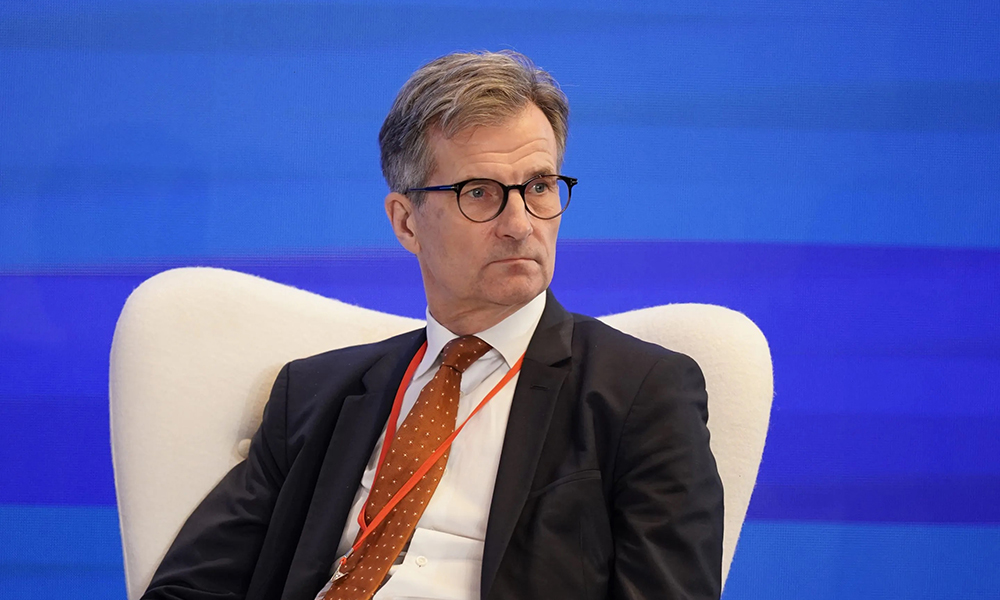
瑞典宣布降息,這一大膽舉措令一些分析師大感意外,,這也意味著全球貨幣政策進(jìn)入了一個(gè)新階段,,可能會(huì)加速經(jīng)濟(jì)擴(kuò)張,或者讓美國(guó)等國(guó)家恢復(fù)更謹(jǐn)慎的貨幣政策,。
5月8日上午,,瑞典中央銀行(Riksbank)將基準(zhǔn)利率從4%下調(diào)至3.75%,此前瑞士和匈牙利等其他歐洲小國(guó)均宣布通脹最嚴(yán)重的時(shí)期已經(jīng)結(jié)束,。
瑞典最常用的通脹指標(biāo)下降至2.2%,,接近瑞典央行2%的目標(biāo)。從表面上來看,,這只是從2022年起通過大幅加息來解決問題這種嚴(yán)謹(jǐn)?shù)呢泿耪攉@得了合理回報(bào),。
但在瑞典經(jīng)濟(jì)衰退的形勢(shì)下,這可能只是一種絕望的信號(hào),。
瑞典央行寫道:“當(dāng)通脹接近目標(biāo)水平而經(jīng)濟(jì)活動(dòng)依舊疲軟時(shí),,可以放寬貨幣政策?!?/p>
“根據(jù)今年3月的預(yù)測(cè),,如果通脹前景保持不變,預(yù)計(jì)今年下半年還將有兩次政策利率的下調(diào),?!?/p>
2023年第四季度,瑞典經(jīng)濟(jì)同比萎縮0.2%,。這是瑞典GDP連續(xù)三個(gè)季度萎縮,。
美聯(lián)儲(chǔ)(Federal Reserve)預(yù)計(jì)將于今年9月或者10月,在其擴(kuò)張周期內(nèi)首次降息,,因此瑞典的降息是本世紀(jì)首次在美國(guó)之前調(diào)整利率,,而且其他小國(guó)可能紛紛效仿。
但長(zhǎng)期以來,,瑞典央行追隨美聯(lián)儲(chǔ)的腳步有合理的理由,,而這次大膽的舉措給它帶來的問題,,可能多于此舉能夠解決的問題。
貨幣問題
在上周發(fā)布的一份報(bào)告中,,摩根士丹利(Morgan Stanley)直言不諱地分析了瑞典如果在5月降息將會(huì)面臨的諸多風(fēng)險(xiǎn),。
摩根士丹利的分析師加布里埃拉·斯洛娃指出,雖然通脹回落,,但油價(jià)上漲,、服務(wù)業(yè)通脹等多方面的壓力,可能使瑞典的宏觀經(jīng)濟(jì)狀況變得更加復(fù)雜,。
此外還有貨幣的問題,,瑞典貨幣的影響力與美元相比不值一提。
預(yù)計(jì)在瑞典央行降息后,,該國(guó)貨幣克朗將會(huì)貶值,。降息通常會(huì)增加貨幣供應(yīng),導(dǎo)致貨幣對(duì)其他貨幣貶值,。而克朗這種小國(guó)貨幣更是如此,。
事實(shí)上,5月8日上午,,在瑞典央行宣布降息之后,,克朗兌美元就貶值了0.5%。
加布里埃拉·斯洛娃寫道:“對(duì)于瑞典這樣一個(gè)小型開放型經(jīng)濟(jì)體而言,,必須高度重視外匯因素,、海外利率預(yù)期和地緣政治變化?!?/p>
與此同時(shí),,美聯(lián)儲(chǔ)對(duì)降息的態(tài)度更加謹(jǐn)慎,努力避免重新陷入數(shù)月來才得以控制的通脹周期,。
但面對(duì)“硬著陸”的威脅,,如果長(zhǎng)時(shí)間加息導(dǎo)致經(jīng)濟(jì)衰退,它就可能不得不選擇降息,。
與此同時(shí),,歐洲央行(European Central Bank)預(yù)計(jì)會(huì)在下周追隨瑞典央行的腳步,進(jìn)行降息,。歐洲是充當(dāng)美國(guó)降息的小白鼠,,還是預(yù)示新一輪經(jīng)濟(jì)衰退的金絲雀,,答案很快就會(huì)揭曉,。(財(cái)富中文網(wǎng))
譯者:劉進(jìn)龍
審校:汪皓
瑞典宣布降息,這一大膽舉措令一些分析師大感意外,,這也意味著全球貨幣政策進(jìn)入了一個(gè)新階段,,可能會(huì)加速經(jīng)濟(jì)擴(kuò)張,,或者讓美國(guó)等國(guó)家恢復(fù)更謹(jǐn)慎的貨幣政策。
5月8日上午,,瑞典中央銀行(Riksbank)將基準(zhǔn)利率從4%下調(diào)至3.75%,,此前瑞士和匈牙利等其他歐洲小國(guó)均宣布通脹最嚴(yán)重的時(shí)期已經(jīng)結(jié)束。
瑞典最常用的通脹指標(biāo)下降至2.2%,,接近瑞典央行2%的目標(biāo),。從表面上來看,這只是從2022年起通過大幅加息來解決問題這種嚴(yán)謹(jǐn)?shù)呢泿耪攉@得了合理回報(bào),。
但在瑞典經(jīng)濟(jì)衰退的形勢(shì)下,,這可能只是一種絕望的信號(hào)。
瑞典央行寫道:“當(dāng)通脹接近目標(biāo)水平而經(jīng)濟(jì)活動(dòng)依舊疲軟時(shí),,可以放寬貨幣政策,。”
“根據(jù)今年3月的預(yù)測(cè),,如果通脹前景保持不變,,預(yù)計(jì)今年下半年還將有兩次政策利率的下調(diào)?!?/p>
2023年第四季度,,瑞典經(jīng)濟(jì)同比萎縮0.2%。這是瑞典GDP連續(xù)三個(gè)季度萎縮,。
美聯(lián)儲(chǔ)(Federal Reserve)預(yù)計(jì)將于今年9月或者10月,,在其擴(kuò)張周期內(nèi)首次降息,因此瑞典的降息是本世紀(jì)首次在美國(guó)之前調(diào)整利率,,而且其他小國(guó)可能紛紛效仿,。
但長(zhǎng)期以來,瑞典央行追隨美聯(lián)儲(chǔ)的腳步有合理的理由,,而這次大膽的舉措給它帶來的問題,,可能多于此舉能夠解決的問題。
貨幣問題
在上周發(fā)布的一份報(bào)告中,,摩根士丹利(Morgan Stanley)直言不諱地分析了瑞典如果在5月降息將會(huì)面臨的諸多風(fēng)險(xiǎn),。
摩根士丹利的分析師加布里埃拉·斯洛娃指出,雖然通脹回落,,但油價(jià)上漲,、服務(wù)業(yè)通脹等多方面的壓力,可能使瑞典的宏觀經(jīng)濟(jì)狀況變得更加復(fù)雜,。
此外還有貨幣的問題,,瑞典貨幣的影響力與美元相比不值一提。
預(yù)計(jì)在瑞典央行降息后,,該國(guó)貨幣克朗將會(huì)貶值,。降息通常會(huì)增加貨幣供應(yīng),,導(dǎo)致貨幣對(duì)其他貨幣貶值。而克朗這種小國(guó)貨幣更是如此,。
事實(shí)上,,5月8日上午,在瑞典央行宣布降息之后,,克朗兌美元就貶值了0.5%,。
加布里埃拉·斯洛娃寫道:“對(duì)于瑞典這樣一個(gè)小型開放型經(jīng)濟(jì)體而言,必須高度重視外匯因素,、海外利率預(yù)期和地緣政治變化,。”
與此同時(shí),,美聯(lián)儲(chǔ)對(duì)降息的態(tài)度更加謹(jǐn)慎,,努力避免重新陷入數(shù)月來才得以控制的通脹周期。
但面對(duì)“硬著陸”的威脅,,如果長(zhǎng)時(shí)間加息導(dǎo)致經(jīng)濟(jì)衰退,,它就可能不得不選擇降息。
與此同時(shí),,歐洲央行(European Central Bank)預(yù)計(jì)會(huì)在下周追隨瑞典央行的腳步,,進(jìn)行降息。歐洲是充當(dāng)美國(guó)降息的小白鼠,,還是預(yù)示新一輪經(jīng)濟(jì)衰退的金絲雀,,答案很快就會(huì)揭曉。(財(cái)富中文網(wǎng))
譯者:劉進(jìn)龍
審校:汪皓
Sweden has taken the bold move of cutting interest rates, surprising some analysts and marking a new phase in global monetary policy that could accelerate economic expansion or return countries including the U.S. to a more cautious approach.
The Riksbank moved on May 8 morning to slash its base interest rate from 4% to 3.75%, following other small European countries including Switzerland and Hungary in declaring the worst was over in the battle with inflation.
Sweden’s preferred measure of inflation has fallen to 2.2%, close to the Riksbank’s target of 2%. On the surface, it is a just reward for disciplined monetary policy that saw interest rates rise sharply from 2022 onward to get ahead of the problem.
But with Sweden’s economy in recession, it may just be a sign of desperation.
“When inflation approaches the target while economic activity is weak, monetary policy can be eased,” the Riksbank wrote.
“If the outlook for inflation still holds, the policy rate is expected to be cut two more times during the second half of the year, in line with the forecast in March.”
Sweden’s economy contracted by 0.2% in the fourth quarter of 2023 compared with the same period in 2022. It was the third quarter in a row that Swedish GDP had contracted.
With the Fed expected to cut interest rates for the first time in its expansion cycle in either September or November, this marks the first time this century that Sweden had moved before the U.S. on an interest rate change, and other small countries might follow.
But there were good reasons for the Riksbank following the Fed’s lead for so long, and its leap of faith might leave it with more problems than it solves.
Currency troubles
In a note published last week, Morgan Stanley didn’t sugarcoat the myriad risks Sweden would be taking if it went ahead with a May rate cut.
While inflation has been falling, Morgan Stanley analyst Gabriela Silova pointed out, several pressures including rising oil prices and higher services inflation complicated the macro picture in Sweden.
There is also the issue of its currency, which commands a small fraction of the power of the U.S. dollar.
Sweden’s currency, the krona, is expected to fall in value following the Riksbank’s interest rate cut. Rate cuts typically weaken currency values by increasing the supply of available money relative to other currencies. This is particularly true for smaller currencies like the krona.
Indeed, the krona fell 0.5% against the dollar on May 8 morning following the Riksbank’s announcement.
“With a small open economy like Sweden’s, it is important to put significant weight onto the FX [foreign exchange] considerations, interest rate expectations abroad, and geopolitical developments,” Gabriela Silova wrote.
The Fed, meanwhile, is taking a more cautious approach to rate cutting, keen to avoid being thrown back into an inflationary cycle that has taken months to tame.
But it may be forced to move under threat of a “hard landing,” if a recession results from a longer period of elevated interest rates.
In the meantime, the European Central Bank (ECB) is expected to follow the Riksbank next week with a rate cut of its own. It will soon be clear whether Europe has been a useful guinea pig for the U.S. on rate cuts, or a canary in the coal mine for a renewed economic downturn.






